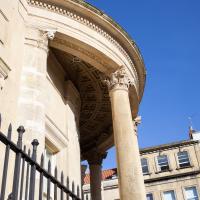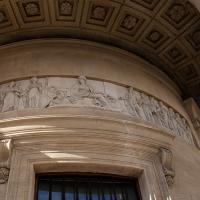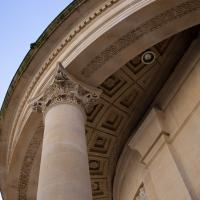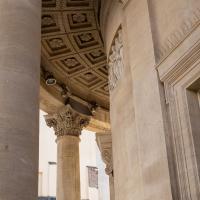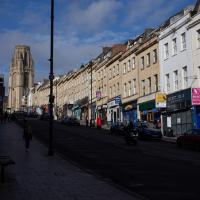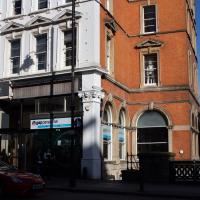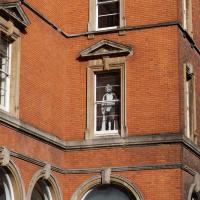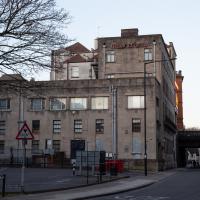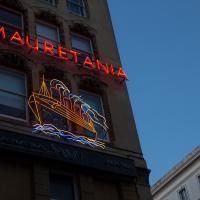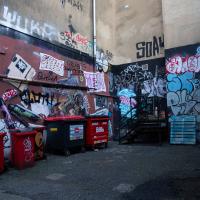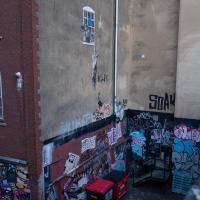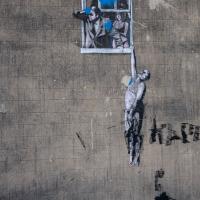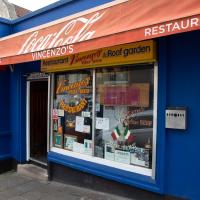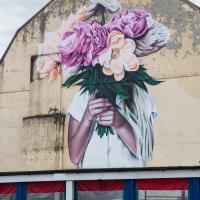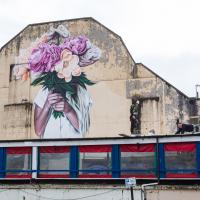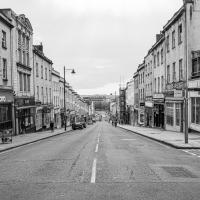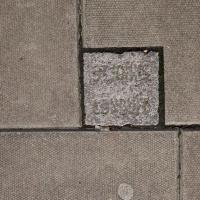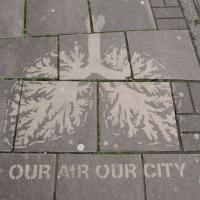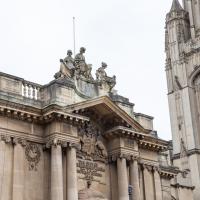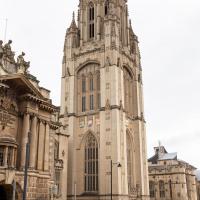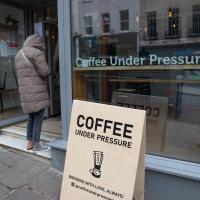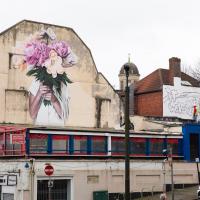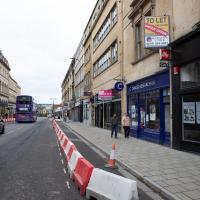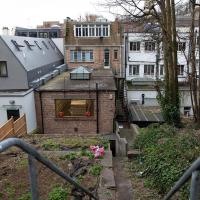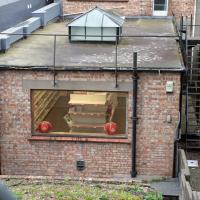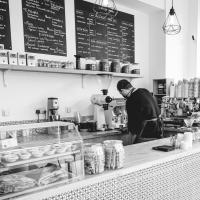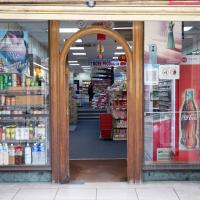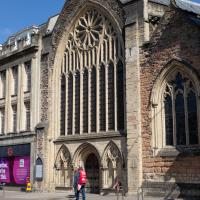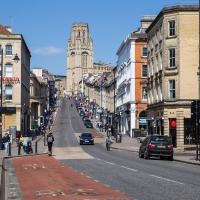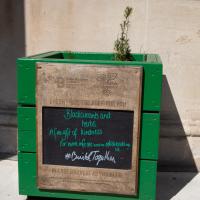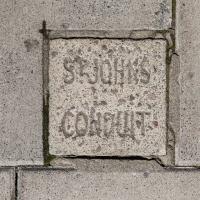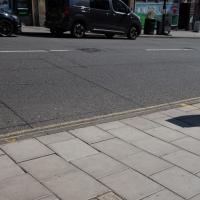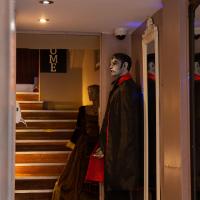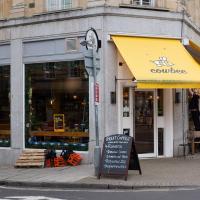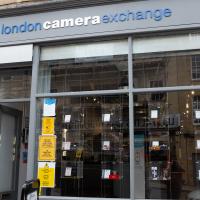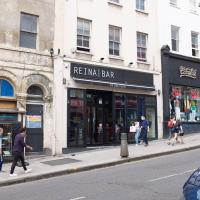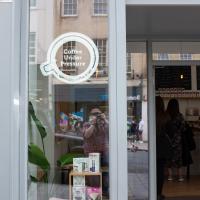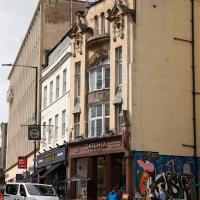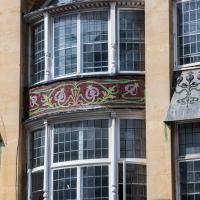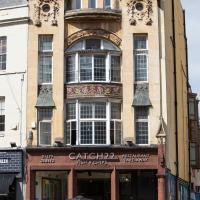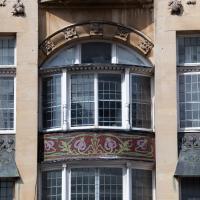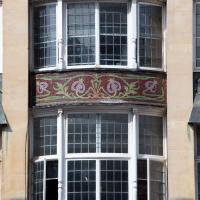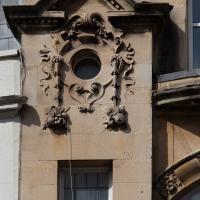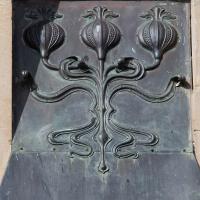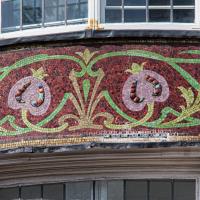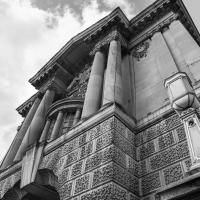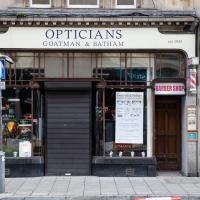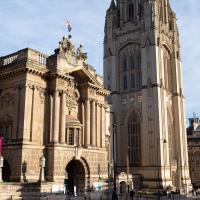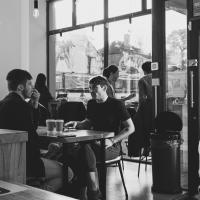Tagged: park-street
In Between
06 Feb 2021
A lovely walk in the early spring sunshine with my friend Lisa. We headed directly for Jacobs Wells Road, to start off around the scene of one of our earlier walks, but this time took in Jacobs Wells from QEH upward, stopping to snap some photos of a Bear With Me, some interesting areas between Park Street and Brandon Hill including a peculiarly quiet enclave with a ruined old build I'd never found before, then crossed the Centre to grab take-away pies from Pieminister (I had the Heidi Pie) and head back to my place down the harbourside.
Well, okay, according to the listing, "deep curved tetrastyle-in-antis porch with Temple of the Winds capitals to an entablature, and a coffered ceiling."
Well, given who occupies this place, you'd expect good masonry work. This is the home of the Freemasons' Provincial Grand Lodge of Bristol. The inside is meant to be pretty special, too, but sadly I missed the last open day. (Not kidding; the hall opens up to visitors on Bristol's popular Open Doors days)
Apparently Big Jeff has been spending lockdown making art. I'm glad he seems to be thriving despite the lack of gigs.
Harbourside Milestone
17 Mar 2021
The other day I realised (hello, Maggie!) that my next walk would be my hundredth, and that I'd done 393.4km so far. I figured it would be nice to get to 100 walks and 400km on the same walk, so I went for a nice long harbourside wander after work, rather than dashing out at lunchtime. As it turned out, we're just coming up to the time of year where I can leave the house at 5:30 in the evening and there's still just enough light to take photos by the time I've made it around the harbourside. Though only just, and mostly because I've got a full-frame camera that's not bad in low light...
Still, the evening light made a lovely change, and some of the photos turned out to be pretty good photos per se, rather than just record shots of my walk. I'm looking forward to more evening walks like this as summer approaches.
On the way around this evening I wandered through one of the oldest bits of the city to extend my walk and snapped some interesting bits of architecture, including an NCP car park(!) and a nighttime shot of one of my favourite subjects, the clock tower at the Albion dockyard.
Some of the furnishings from the RMS Mauretania were installed in a bar/restaurant complex at the bottom of Park Street... The lounge bar was the library with mahogany panelling: above the first-class Grand Saloon with French-style gilding overlooks Frog Lane. The neon sign on the south wall still advertises the "Mauretania": installed in 1938 this was the first moving neon sign in Bristol.
— Mauretania Public House, Wikipedia
Oddly, everyone in Bristol knows the wall above this little alleyway/loading bay, but probably woudln't recognise this bit down here.
It's seen better day. Virtually every Banksy appears to be either vandalised or stolen as soon as it turns up in Bristol these days. Wikipedia even has an article devoted to a list of his works that have been destroyed.
I got interested in Bristol's medieval water supplies after poking around near Jacobs Wells Road and Brandon Hill. It was during that research I found out about a pipe that's still there today, and, as far as I know, still actually functioning, that was originally commissioned by Carmelite monks in the 13th century. They wanted a supply of spring water from Brandon Hill to their priory on the site of what's now the Bristol Beacon—Colston Hall, as-was. It was created around 1267, and later, in 1376, extended generously with an extra "feather" pipe to St John's On The Wall, giving the pipework its modern name of "St John's Conduit".
St John's on the Wall is still there, guarding the remaining city gate at the end of Broad Street, and the outlet tap area was recently refurbished. It doesn't run continuously now, like it did when I first moved to Bristol and worked at the end of Broad Street, in the Everard Building, but I believe the pipe still functions. One day I'd like to see that tap running...
There are a few links on the web about the pipe, but by far the best thing to do is to watch this short and fascinating 1970s TV documentary called The Hidden Source, which has some footage of the actual pipe and also lots of fantastic general footage of Bristol in the seventies.
On my walk today I was actually just going to the building society in town, but I decided to trace some of the route of the Carmelite pipe, including visiting streets it runs under, like Park Street, Christmas Street, and, of course, Pipe Lane. I also went a bit out of my way to check out St James' Priory, the oldest building in Bristol, seeing as it was just around the corner from the building society.
There are far too many pictures from this walk, and my feet are now quite sore, because it was a long one. But I enjoyed it.
Believe it or not, this little pavement marker says "St John's Conduit" and marks the still-functional Carmelite water pipe that was built in 1267 to bring water from a spring near the top of Park Street to the Priory where Bristol Beacon now stands, with a "feather" branch added later (1376) to bring water to St John's church. Source: Bristol's Fascinating Fountains, Temple Local History Group
Clever: stencil out the pavement, then pressure-wash it, to make your point by highlighting the discolouration that's partly caused by airborne particulate pollution.
Never tried them before, but they did me a great flat white and I'll be going back.
I bumped into my friend Lisa in town during yesterday's wander, and we decided to have a wander today, too. We managed quite a long ramble, starting up through Clifton and nipping down Park Row to investigate the two tower blocks I'd noticed popping up behind Park Street yesterday, then took in a few roads I'd not managed to get to before, including cutting through the grounds of Bristol Grammar School.
Man on a Mission
17 Apr 2021
I went rather outside my area today, as I went to pick something up from the Warhammer shop on Wine Street (Games Workshop as-was, and before that I think perhaps a rare retail outlet for Her Majesty's Stationery Office? I may be mis-remembering...) Anyway, a friend of mine wanted something picking up and posting to him, so I figured I'd knock some streets off my list along the way.
I first headed for the St George's Road area, walking down the narrow Brandon Steps and finding some strange wall art on Brandon Steep, then headed to the Old City via Zed Alley. The Warhammer shop visit was friendly and efficient, and, mission accomplished, I treated myself to a sausage roll and a flat white from Spicer + Cole, to take away and eat in Queen Square with its current decoration of hearts. I finished off with a detour up Park Street, looking out for St John's Conduit markers, before finally crossing Brandon Hill on the way home.
Quite a long wander, all told, and I'm a bit knackered today...
I've mentioned the Lord Mayor's Chapel before when wandering the area behind it, where the Gaunts Hospital used to stand. Now known as either the Lord Mayor's Chapel or St Mark's Church, it was formerly (i.e. before 1722!) known as Gaunt's Chapel. It was built around 1230, and named after Maurice de Gaunt, who founded both the Gaunt's Hospital and this, its attached chapel.
I found another marker for the 13th century Carmelite lead water pipe that runs under Park Street.
A Longer-than-it-looks Walk With Lisa
06 Jun 2021
The track on the map doesn't tell the whole story of this walk with Lisa around and about Clifton, Berkeley Square, Brandon Hill and the harbourside, because the batteries on my GPS ran out while we were on the roof of Trenchard Street car park, it seems. Oh well. I think I did most of the area I was interested in finishing off around the University; there were only a few new bits around Brandon Hill that won't be on the track, and I can easily do them again.
Still, technology woes aside it was a nice walk, albeit a bit warm for climbing all those hills, and sat on the harbourside watching the world go by for a while, too. It was good to see the Bristol Ferry Boats carrying people around again, especially.
A snap in the entrance of the Transylvanian restaurant on Park Street, leaning into their image as hard as possible.
Library, Bookshop, Coffee
03 Jul 2021
I was headed into town to return RA Gilbert's biography of AE Waite to the library and along the way I noticed that Dreadnought had finished their refurbishment, but wouldn't be open until midday. That left me some time to kill, so I bimbled around the old St Augustine's/Gaunt's area for a while, then headed up Park Street for a coffee and a snack to eat on Brandon Hill before heading home the way I'd came so I could pop in and buy a pamphlet on the Hot Well I'd been interested in for a while.
Interesting logo. Apparenlty milk and honey feature prominently in their menu. Not one for the vegans, I'm guessing.
I had no idea that both branches of London Camera Exchange (I always favoured the tiny shop at the end of Baldwin Street, but they also had one on the Horsefair) had been consolidated into a single shop on Park Street. It looks nice and shiny and modern, but I shall miss the quirk of the Baldwin Street shop.
This used to be the Park Street Convenience Store (formerly a Spar), which I don't think I ever set foot in, so it certainly has a lot more appeal to me now.
Call me thick, but I think this may be the first time I've realised what Coffee Under Pressure's acronym is. D'oh. (You could also call me think just looking at the outline of me reflected in the window. I do need to lose some more weight...
A Long Wander Of Miscellany and Magick
08 Aug 2021
This was a wide-ranging wander. I started off crossing the river to Bedminster, to walk a single little cul-de-sac, Hardy Avenue, that I'd managed to miss on at least one previous walk. Then, pausing only to explore a few back alleyways, I headed for a few destinations related mostly by the Hughes family, who I've been researching a little as part of background for a possible novel, as several of them were involved in the Stella Matutina.
However, mostly it's the artistic side of the family I wanted to explore today, as that's where most of their public history lies (as you might expect, there's often not much in the public record about the workings of an occult organisation.) First I visited College Green, where the façade of the Catch 22 Fish & Chip shop still bears the work of Catherine Edith Hughes. Then I wandered up to the top of Park Street to pop into the Clifton Arts Club's annual exhibition, as Catherine, her half-brother Donald, his wife Hope and at least two other Hugheses were members. Donald was chairman for 40 solid years; Hope was Secretary for eight, and Ellard and Margaret Hughes, two more Hughes siblings, were members along with Catherine.
Finally I walked home with a small diversion to Berkeley Square, to confirm the location of Donald Hughes's house by checking for a particular plaque by the front door.
I must admit I'm not entirely sure where all this research is really leading me, but I'm finding it quite interesting to bump across the faint lines of history that link the Hermetic Order of the Golden Dawn, founded in 1888, to modern, quotidian Bristol.
These days it's a fish and chip shop, but it started as the Cabot Cafe.
According to this description of an etching by Alexander Heaney:
Built in 1904 for an estate agent, Walter Hughes, to the design of Latrobe & Weston, architects well known for their cinemas. Above the word ‘Café’ can just be seen the Pomegranate mosaic with enamel insets by the client's daughter, Catherine Hughes, taken from Charles Rickett's bookbinding for Oscar Wilde's A House of Pomegranates, 1891.
Caroline's Miscellany tells us:
Less bright, but equally beautiful, are the copper panels to either side. These continue the pomegranate theme and are pure Art Nouveau. Other details, by contrast, are more baroque (a mixture of styles characteristic of LaTrobe and Weston's work).
Cabot Cafe suffered damage in the Second World War. We are fortunate, then, that this intriguing facade nevertheless survived to delight us today.
As I mentioned, these pomegranates were made by Catherine Hughes, daughter of the estate agent who commissioned the cafe.
The Hughes name is one to conjure with. I'm specifically interested in the Hughes family as I've been researching the Golden Dawn1 for a novel, and at least three Hugheses were members of its later offshoot, the Stella Matutina. Catherine Hughes (Lux Orta Est), who made these tiled pomegranates was, I believe, the first Imperatrix of the No. 28 Bristol Hermes Temple of the Stella Matutina, running it to begin with from her home at St Vincent's Studio, Redland, just off the top of Whiteladies Road.
We'll be hearing a bit more about some other members of the Hughes family in a little bit, as I decided to turn this wander into a bit of a magical excursion, for fun and research and because of handy timing and geographical coincidence.
I don't know if these pomegranates from 1904 predate Catherine Hughes's interest in magic per se, but they were made years before she joined the Stella Matutina, in early 1908, so I can't say that they were created by a practising magician!
1 No, not the Greek nutters. The British Victorian, er, eccentrics.
The side window canopies are copper, as you can probably tell by the green streaks below them.
Must've taken some time to put together. And done with some skill, to still look so good nearly 120 years later.
City Museum and Art Gallery. Though when it was donated by Henry Wills (you can just see The Gift of... in the inscription) it was just The Bristol City Art Gallery.
Quick Clifton Jaunt Finishing with Southville
09 Jan 2022
It's been pretty dismal recently, weather-wise, so when Sarah called up to say that she and Vik had just left the swimming pool at the student union building up in Clifton, and would I like to join them for a trip to the Last Bookshop, also known as The £3 Bookshop, for reasons you can probably deduce, I leapt at the chance.
Not many photos on this walk, but I did manage to get down a little road I'd never been to before, basically just the access road to a car park at a block of flats, but it was on the map looking all tempting, so I figured I'd knock it off the list as we were passing.
The museum and the Wills Memorial looking resplendent. Behind me on this chilly morning was someone sleeping in a doorway under a quilt, with a plastic suitcase presumably containing their entirely worldly possessions. It's a place of contrasts, Clifton.
I love Coffee Under Pressure's coffee, so I usually grab something from them when I'm passing. I've got to admit, though, being in a relatively confined space with a bunch of other people is giving me the heebie-jeebies a bit in the time of the Omicron variant. I got a quick take-out, wearing my mask, and ran.
